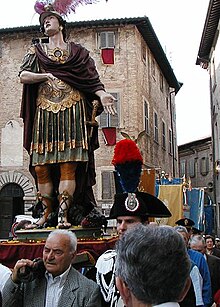Crescentinus
Crescentinus | |
|---|---|
 A statue of Crescentinus borne in procession in the streets of Urbino for his feast day. | |
| Martyr | |
| Died | ~303 AD |
| Venerated in | Roman Catholic Church Eastern Orthodox Church |
| Major shrine | Urbino Cathedral |
| Feast | 1 June |
| Attributes | Military attire, depicted slaying a dragon |
| Patronage | Urbino, Città di Castello, invoked against headache |
Saint Crescentinus (Italian: San Crescentino, Crescenziano) (died June 1, 303) is the patron saint of Urbino whose feast day is celebrated on June 1. Venerated as a warrior saint, he is sometimes depicted on horseback, killing a dragon, in the same manner as Saint George. However, as Martin Davies writes, "S. Crescentino’s story, so far as I am aware, excludes a Princess or other female victim."[1]
Legend[edit]
Crescentinus is traditionally said to have been a Roman soldier who converted to Christianity. To escape the persecutions of Diocletian, he fled to Umbria, and found refuge at Thifernum Tiberinum (present-day Città di Castello). His defeat of a dragon led to a successful evangelization of the region, together with his companions. His mission was confined particularly to the Tiber Valley and the ancient Thifernum Tiberinum. He was subsequently beheaded.
Veneration[edit]
Wishing to enrich his cathedral, Blessed Mainard (Mainardo), the Bishop of Urbino, brought the saint's relics to the city in 1068.[1]
The coin known as the armellino (popularly called the volpetta) issued by the Duke of Urbino, Francesco Maria I della Rovere, featured Saint Crescentinus on horseback.[2]
He is still venerated in Urbino, where his statue is carried through the streets in a procession on his feast day. Another ritual involves tapping devotees’ heads with Crescentinus' relics, to free the supplicant from headaches. [2]
Gallery[edit]
-
San Crescenziano uccide il drago (Saint Crescentinus kills the dragon), Marco Benefial 1747–49. Cathedral of Città di Castello
External links[edit]
- (in Italian) San Crescentino
- (in Italian) L'omelia di S.E.R. il Cardinale Sergio Sebastiani
Notes[edit]
- ^ Martin Davies, "Uccello's 'St George' in London," Burlington Magazine, Vol. 101, No. 678/679 (Sep. - Oct., 1959), pp. 308-315
- ^ it:Monete italiane medioevali
Further reading[edit]
Information about this saint may be found in the Acta Sanctorum, as well as in Angelo Conti, Fiori Vaghi delle Vite dei Santi e Beati delle Chiese, e Reliquie della Città di Castello (1627), pp-45ff.

